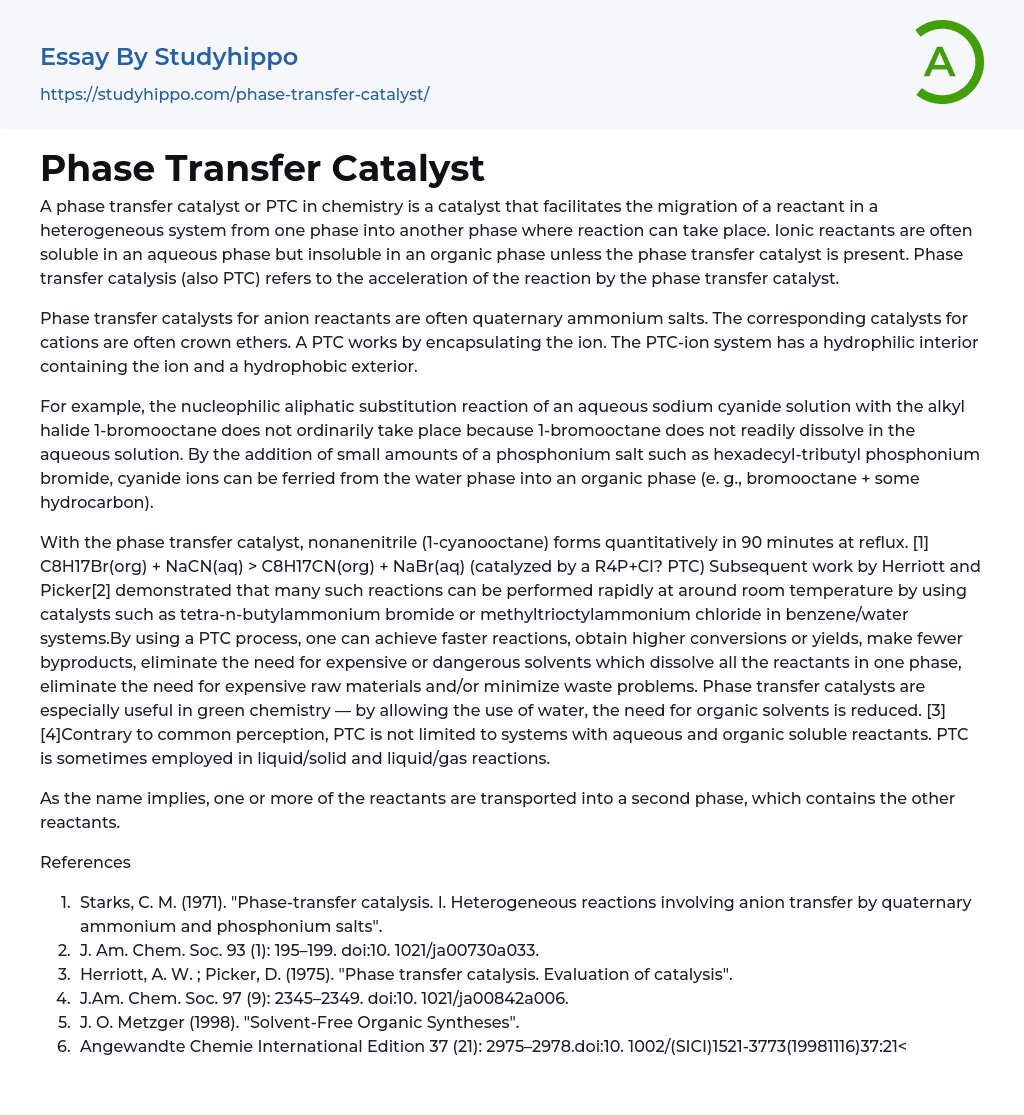A phase transfer catalyst or PTC in chemistry is a catalyst that facilitates the migration of a reactant in a heterogeneous system from one phase into another phase where reaction can take place. Ionic reactants are often soluble in an aqueous phase but insoluble in an organic phase unless the phase transfer catalyst is present. Phase transfer catalysis (also PTC) refers to the acceleration of the reaction by the phase transfer catalyst.
Phase transfer catalysts for anion reactants are often quaternary ammonium salts. The corresponding catalysts for cations are often crown ethers. A PTC works by encapsulating the ion. The PTC-ion system has a hydrophilic interior containing the ion and a hydrophobic exterior.
For example, the nucleophilic aliphatic substitution reaction of an aqueous sodium cyanide solution with the alkyl halide 1-bromooctane does not ordinarily take place because 1-bromooctane does not readily dissolve in
...the aqueous solution. By the addition of small amounts of a phosphonium salt such as hexadecyl-tributyl phosphonium bromide, cyanide ions can be ferried from the water phase into an organic phase (e. g., bromooctane + some hydrocarbon).
With the phase transfer catalyst, nonanenitrile (1-cyanooctane) forms quantitatively in 90 minutes at reflux. [1] C8H17Br(org) + NaCN(aq) > C8H17CN(org) + NaBr(aq) (catalyzed by a R4P+Cl? PTC) Subsequent work by Herriott and Picker[2] demonstrated that many such reactions can be performed rapidly at around room temperature by using catalysts such as tetra-n-butylammonium bromide or methyltrioctylammonium chloride in benzene/water systems.By using a PTC process, one can achieve faster reactions, obtain higher conversions or yields, make fewer byproducts, eliminate the need for expensive or dangerous solvents which dissolve all the reactants in one phase, eliminate the need for expensive raw
materials and/or minimize waste problems. Phase transfer catalysts are especially useful in green chemistry — by allowing the use of water, the need for organic solvents is reduced. [3][4]Contrary to common perception, PTC is not limited to systems with aqueous and organic soluble reactants. PTC is sometimes employed in liquid/solid and liquid/gas reactions.
As the name implies, one or more of the reactants are transported into a second phase, which contains the other reactants.
References
- Starks, C. M. (1971). "Phase-transfer catalysis. I. Heterogeneous reactions involving anion transfer by quaternary ammonium and phosphonium salts".
- J. Am. Chem. Soc. 93 (1): 195–199. doi:10. 1021/ja00730a033.
- Herriott, A. W. ; Picker, D. (1975). "Phase transfer catalysis. Evaluation of catalysis".
- J.Am. Chem. Soc. 97 (9): 2345–2349. doi:10. 1021/ja00842a006.
- J. O. Metzger (1998). "Solvent-Free Organic Syntheses".
- Angewandte Chemie International Edition 37 (21): 2975–2978.doi:10. 1002/(SICI)1521-3773(19981116)37:21<2975::AID-ANIE2975>3. 0. CO;2-A.
- Mieczyslaw Makosza (2000). "Phase-transfer catalysis. A general green methodology in organic synthesis".
- Pure Appl. Chem. 72 (7): 1399–1403. doi:10.1351/pac200072071399.
- Distillation essays
- Amylase essays
- Magnesium essays
- Acid essays
- Calcium essays
- Carbohydrate essays
- Carbon essays
- Chemical Bond essays
- Chemical Reaction essays
- Chemical reactions essays
- Chromatography essays
- Concentration essays
- Copper essays
- Diffusion essays
- Ethanol essays
- Hydrogen essays
- Organic Chemistry essays
- Osmosis essays
- Periodic Table essays
- Ph essays
- Salt essays
- Sodium essays
- Titration essays




